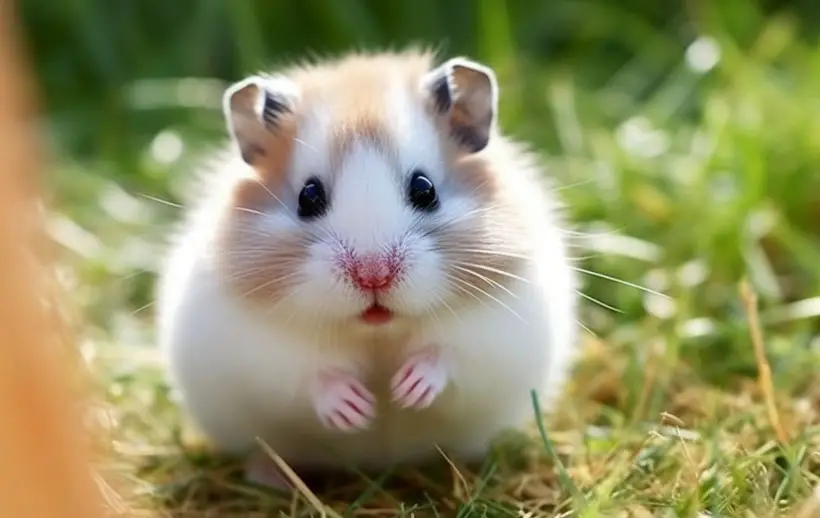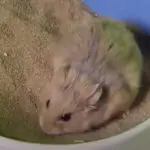Chinese Dwarf Hamster Care: Food, Habitat, Health, and Facts
Chinese Dwarf Hamsters are not actual “dwarfs.” But, they are often called that because of their small size compared to other hamster species. Like any pet, they have specific needs and preferences that you should know before bringing them home.
So, what’s there to know about Chinese Dwarf Hamster care? Well, they need a comfortable and spacious habitat. Besides, you must also offer a healthy diet, nutrition, and enough scope for physical stimulus as well.
But there’s a lot more to know about caring for them. So, in this post, we will provide you with comprehensive information on how to care for your Chinese dwarf hamster. By the end of this article, you will be well-equipped to give your Chinese dwarf hamster the best life possible. Let’s get started!
Proper Nutrition For Chinese Dwarf Hamsters

Proper nutrition is crucial for the well-being of your Chinese Dwarf Hamster. So, here are some tips to ensure that your furry friend is getting the ideal diet:
1. Ideal Diet for Chinese Dwarf Hamsters:
There are a few ways to go about when you’re trying to offer the ideal diet to your pet critter. Let’s check ’em out below:
1. Balanced commercial food mix:
Commercial hamster food provides a well-balanced diet that meets all the nutritional requirements of your pet. These mixes usually consist of grains, seeds, vegetables, and fruits.
Some good examples of balanced commercial food mix for pet hamsters are:
- A mix of grains, such as corn, oats, and barley, with a protein source, such as chicken or fish meal, and a vegetable source, such as carrots or peas.
- A mix of fruits and vegetables, such as apples, bananas, and spinach, with a grain source, such as brown rice, and a protein source, such as tofu or beans.
- A mix of nuts and seeds, such as almonds, walnuts, and chia seeds, with a fruit source, such as berries, and a vegetable source, such as kale.
Follow these additional tips for choosing a balanced commercial food mix:
- Look for a mix that is high in fiber and low in sugar.
- Choose a mix that is made with whole grains and lean protein sources.
- Avoid mixes that contain artificial flavors, colors, or preservatives.

B. Fresh vegetables and fruits:
Hamsters can enjoy a variety of fresh fruits and vegetables as treats. Here are some fruits and vegetables that are generally safe for hamsters:
Vegetables:
- Carrots
- Broccoli
- Cauliflower
- Cucumber
- Bell peppers (red, yellow, and green)
- Spinach (in small amounts)
- Zucchini
- Peas
- Kale (in small amounts)
- Romaine lettuce (avoid iceberg lettuce as it has little nutritional value)

Fruits:
- Apple (Remove seeds because they can contain cyanide)
- Banana
- Blueberries
- Strawberries
- Raspberries
- Blackberries
- Cherries (remove pits)
- Pear
- Grapes (in moderation, as they can be high in sugar)
- Melon (small amounts and remove seeds)
C. Occasional treats and supplements:
It’s okay to give your hamster occasional treats, such as plain yogurt, plain cooked chicken, or mealworms. You can also provide supplements, such as calcium and vitamin drops.

2. Foods to Avoid:
There are some foods that can be toxic or cause digestive problems to your pet hamsters. These include chocolate, caffeine, alcohol, onions, garlic, and citrus fruits.
3. Hydration and Water Bottle Considerations:
A water bottle is the best way to provide water, as it prevents spillage and keeps the water clean.
The water bottle should be attached to the side of the hamster cage using a mounting bracket. And it should be placed at a height that is comfortable for the hamster to drink from, typically about 2-3 inches above the bedding.
Moreover, make sure the water bottle is secure and cannot fall off the cage. Check the water level daily and refill as needed.
You should also consider cleaning the water bottle regularly to prevent bacteria growth. And replace the water bottle every 3-4 months.
Creating the Ideal Habitat for Your Chinese Dwarf Hamster
This adorable pet needs proper habitation while in captivity. You should ensure the proper habitat for your Chinese dwarf hamsters as follows.

1. Choosing the right cage
The quality of the cage environment does matter when it comes to your hamster’s home. Chinese Dwarf Hamsters may be tiny, but they love to explore and need quality space to roam. Some important stuff should be taken into account while choosing the cage. Such as:
1. Size and material recommendations
Aim for a cage with a minimum of 450 square inches (2,900 square cm) of floor space. Bigger is always better, so why not spoil your pet with a spacious abode?
Materials matter too. Choose a cage made of sturdy wire or clear plastic. Glass aquariums are an option, but they can be heavy and may not provide the best ventilation. Remember, a well-ventilated cage is a happy hamster home.
2. Multi-level vs single-level cages
To go multi-level or not? That is the question. Multi-level cages can be a great way to maximize your hamster’s living space, especially if you’re limited in horizontal space. They also encourage climbing, keeping your little friend active and engaged.
On the other hand, single-level cages can be easier to clean and maintain. Ultimately, the choice is yours. You must do what your resources permit.
2. Bedding options and considerations
You’ll want to choose something absorbent, comfortable, and safe for your hamster, right? Paper-based bedding is a popular choice because it’s non-toxic and cozy. Aspen shavings are another good option.
But avoid cedar or pine shavings, as they can be harmful to your furry friend’s respiratory activity. It’s suggested by a 2006 study by Laboratory Animals, a peer-reviewed journal.
3. Entertainment items and toys
Who doesn’t love a good workout or recreational activity? Your pet does too. So, entertainment items are vital for them. Some of them are mentioned below:

1. Exercise wheel
An exercise wheel is a must for any hamster habitat. Choose a solid, wide wheel to protect your pet’s tiny feet, ideally around 6.5 inches (16.5 cm) in diameter. Trust me, your hamster will thank you!
2. Hideouts and tunnels
Do you ever feel like hiding away? So do hamsters. Providing hideouts and tunnels in your hamster’s cage will allow them to feel secure and retreat when they need some alone time.
You can purchase pre-made hideouts or get creative with cardboard tubes and small boxes.
3. Climbing structures
As found in the 2019 research published in the National Library of Medicine journal, hamsters are natural-born climbers, so why not let them live their best life? Add some climbing structures like branches, wooden platforms, or ladders to keep them entertained and physically active.
4. Maintaining a clean and hygienic environment
Cleanliness and hygiene are next to hamster happiness. To ensure it, employ the below techniques:
1. Cleaning Schedule
Develop a regular cleaning schedule to maintain your hamster’s habitat. Spot clean daily to remove soiled bedding and uneaten food, and perform a thorough cage cleaning at least once a week.
2. Proper sanitization methods
When cleaning your hamster’s cage, it’s essential to use non-toxic, pet-safe cleaning products. A mix of water and white vinegar can do the trick.
Scrub the cage and accessories well. Don’t forget to rinse and dry them thoroughly before returning your hamster to its freshly cleaned home.
5. Location and temperature control
Choose a location away from direct sunlight, drafts, and noisy areas. Chinese Dwarf Hamsters prefer a stable temperature range between 65°F and 75°F (18°C and 24°C).
Remember, consistency is key – sudden temperature fluctuations can stress out your little buddy. When considering the cage’s location, also keep in mind your hamster’s nocturnal nature.
Placing the habitat in a quiet area of your home, where nighttime activities won’t disturb them, is essential for their well-being.
Health and Wellness for Chinese Dwarf Hamsters
Chinese Dwarf Hamsters, like all pets, can face a variety of health issues. Ensuring their wellness means understanding these common problems and taking steps to prevent them.

1. Common health issues and prevention
Let’s dive into the most frequent issues and explore how you can keep your furry friend healthy and happy.
1. Dental problems
Did you know that a hamster’s teeth never stop growing? That’s right! Dental issues can arise when their teeth become overgrown or misaligned.
To avoid this, provide your hamster with chew toys and hard foods that help wear down their teeth naturally.
Here’s our recommended list of chew toys suitable for hamsters:
- Wooden toys (untreated hardwood such as applewood, pearwood, or willow sticks).
- Store-bought chew toys (wooden chew sticks, wooden blocks, etc.).
- Toilet paper or paper towel rolls (after removing adhesive and paper).
- Popsicle sticks (plain, untreated ones).
- Hay cubes (compressed Timothy hay cubes).
Don’t forget to check their teeth regularly for any signs of abnormal growth or discoloration.
2. Respiratory infections
Poor ventilation and damp conditions can lead to respiratory infections in your Chinese Dwarf Hamster.
Well, ensure their cage is clean, well-ventilated, and away from drafts. Keep an eye on your hamster’s breathing and listen for any signs of wheezing or labored breathing. A healthy environment goes a long way in keeping those little lungs in tip-top shape.
3. Skin conditions
You might notice your hamster scratching excessively or losing fur. It means they may be suffering from a skin condition caused by mites, allergies, or fungal infections.
To prevent this, maintain a clean living space. However, if your hamster has already gotten infected, see a vet as soon as possible. Your hamster’s life will depend on it.
4. Parasites
Nobody likes uninvited guests. Your Chinese Dwarf Hamster is no exception! Parasites, such as mites and ticks, can cause discomfort and illness.
Regularly inspect your hamster’s fur and living space to ensure they remain parasite-free. Sometimes, prevention is as simple as keeping their environment clean and tidy.
Care for Breeding and Reproduction of Chinese Dwarf Hamsters
These little creatures can breed quickly and efficiently. In fact, Chinese Dwarf Hamsters reach sexual maturity at around 2-3 months of age. Quite young, isn’t it?

So, you must ensure the proper care for your pet little friend.
1. Preparing for a Pregnant Hamster and the Birthing Process
A pregnant female requires extra care. First, ensure she has a larger, clean, and secure cage to accommodate her growing belly and future pups. Don’t forget to provide soft bedding materials like tissue paper or unscented toilet paper for her to create a cozy nest.
The gestation period for a Chinese Dwarf Hamster is around 18-21 days. As it approaches, increase the mother’s protein intake with treats like mealworms or small pieces of boiled egg.
Remember, a stressed hamster may become aggressive or even cannibalize her pups. So, keep the environment calm and limit disturbances during the birthing process. And, of course, give the new mom some privacy.
2. Caring for a Nursing Mother and Her Pups
Newborn pups are tiny, hairless, and fragile, so their care is of utmost importance. But don’t worry! The mother will do most of the work.
Your role? Supporting her by providing nutritious food, clean water, and maintaining a calm environment.
Keep in mind that pups should not be touched for at least the first week to avoid stressing the mother. At around 10 days, the pups will begin to develop fur, and by day 14, they’ll open their eyes.
At this point, you can gradually introduce solid food, like small pieces of fruits and vegetables.
3. Separating and Rehoming Offspring
At 3-4 weeks old, the pups will be weaned and ready for separation. Why separate them? Well, to avoid potential conflicts and unplanned breeding, of course!
Males should be housed separately from females, as they can start reproducing as early as 6-8 weeks old.
Socialization and Handling for Chinese Dwarf Hamsters
Chinese Dwarf Hamsters are generally known to be social and tolerant. However, this doesn’t mean they’ll always get along swimmingly with every hamster they encounter.

1. Introducing multiple hamsters: Do’s and Don’ts
Thinking about introducing a new hamster friend to your existing Chinese Dwarf Hamster? Great idea. But it’s crucial to follow some essential do’s and don’ts.
Here we go:
Do’s:
- Quarantine: First off, make sure to quarantine the new hamster for at least two weeks to ensure they’re healthy and free of any illnesses or parasites.
- Neutral territory: Introduce the hamsters in a neutral environment, like a playpen, to avoid any territorial disputes.
- Gradual introductions: Begin with short, supervised interactions and gradually increase their length over time.
- Observe body language: Keep a close eye on their body language for any signs of aggression or distress. Separate them immediately if necessary.
Don’ts:
- Rush the process: Never force interactions. Always allow the hamsters to adjust to each other at their own pace.
- Overcrowding: Ensure their living space is large enough to accommodate both hamsters comfortably. Provide separate hiding spots, food dishes, and water bottles to reduce competition.
2. Tips for safe and stress-free handling
How can you make sure that you’re handling your Chinese Dwarf Hamster safely and without causing them to stress? Here are some tips:
- Patience: Allow your hamster to become comfortable with your presence by spending time near their cage and offering treats.
- Gentle approach: When your hamster seems more relaxed, slowly scoop them up from underneath rather than grabbing from above. Otherwise, you will remind them of a predator.
Frequently Asked Questions
Let’s go over some commonly asked queries regarding caring for Chinese Dwarf Hamsters:
1. Can Chinese Dwarf Hamsters live together with other hamster species?
We generally do not recommend housing Chinese Dwarf Hamsters with other hamster species. They can be aggressive and territorial towards other species of hamsters.
It’s because they are naturally solitary animals and can become aggressive towards each other even if they are from the same species.
2. Do Chinese Dwarf hamsters like a water bath?
No, Chinese Dwarf hamsters do not typically enjoy or require a water bath. In fact, it can be stressful and even harmful to their health.
Chinese Dwarf hamsters are desert-dwelling animals and are not adapted to swimming or being in the water for extended periods. They have specialized oil glands that keep their fur clean and healthy, so they do not need frequent bathing.
3. Do Chinese Dwarf hamsters need vaccines?
No, they don’t. In fact, there are currently no vaccines available specifically for Chinese Dwarf hamsters. However, as with all pets, you must keep their living environment clean and provide proper nutrition and care to prevent illness.
Conclusion
As the end note of this guide to Chinese Dwarf Hamster care, we must recap everything. So, first and foremost, remember the importance of a comfortable and spacious habitat.
Furthermore, keep in mind that a healthy diet and nutrition are key as well. Pet ownership is not all fun and games. It comes with a great deal of responsibility.
Now go ahead and embrace the challenges and delights that come with being a hamster owner!





